Eating Grass
Why Maltese Eat Grass and How to Prevent It
Overview
If your Maltese puppy or dog has the habit of eating grass, you may be wondering why in the world this happens, if there are any dangers in doing so, and, importantly, how to stop it.
There are several reasons why a dog may develop this habit, yet fortunately making some changes can usually put a stop to it. And, it is always a good idea to take steps toward resolving this as soon as possible since this common canine behavior is not a healthy one.
This section will cover everything you need to know if your Maltese likes to chew on and/or ingest grass in your yard, at the park, or out along the walking route.
The Negative Consequences of a Maltese Ingesting Grass
Owners often question if it’s bad for a Maltese to eat grass. And, while fresh green blades of grass may seem harmless, there are actually quite a few reasons why this can be detrimental. Let’s take a look at the top concerns:
1. It can induce vomiting
– Some time ago, experts believed that dogs ate grass to intentionally make themselves throw up in an effort to relieve an upset stomach. However, we now know that this is most likely not true based on studies that show only about 25% of dogs vomit when eating grass. However, this means there is a possibility that a Maltese will throw up during or right after eating grass, often due to the texture and consistency of the blades that causes a gag reflex.
2. It can cause digestive distress
– Though grass is a food source for some animals (like cows that have 4 chambers that can handle grass or horses that have intestinal microbes that are able to efficiently digest grass), this is not so for canines. Grass contains very high levels of cellulose fiber that make it very hard to digest. For this reason, when a Maltese eats grass, there is always the risk of intestinal discomfort, constipation, or even intestinal blockage which can be quite dangerous.
3. It can lead to the ingestion of chemicals
– While grass may look very plain, there may be the presence of lawn care chemicals including pesticides, weed killer, and fertilizers. Even if you do not use these at home, rain can cause run-off from neighboring homes. And, if your Maltese eats grass in public areas like the park or while taking a walk, there is no telling what sort of chemicals there are. Note that city services that post signs warning of lawncare applications often remove the signs when grass is safe to walk upon; there can be lingering chemicals that make it dangerous for your Maltese to ingest it.
4. It can lead to the ingestion of other toxic elements
– Even if your Maltese’s intention is just to eat grass, other things may be accidentally mouthed or ingested. This includes the over 700+ poisonous plants and flowers that exist, toxic mushrooms, stinging insects, and poisonous toads (some of which can cause breathing distress
and seizures just by contact alone).
5. It can cause tooth decay
– If you are working hard to keep your Maltese’s teeth healthy, it will be an uphill battle if your little one eats grass. This is because grass contains silicon which is drawn up from the soil. This is a very abrasive compound that, over time, can wear down the protective enamel on the teeth, leading to increased rates of tooth decay.
6. It can get in the way of nutritional intake
– Grass does not provide any real nutrients, but it does fill up the tummy. So, if your Maltese is eating grass, it can make your dog feel full, ruining appetite for real food. Since every bite counts for toy breeds like the Maltese, you won’t want any of those to be wasted on blades of grass, but rather on high-quality food that provides the right balance of protein, carbs, and healthy fats, along with vitamins and minerals.
Incoming cuteness...

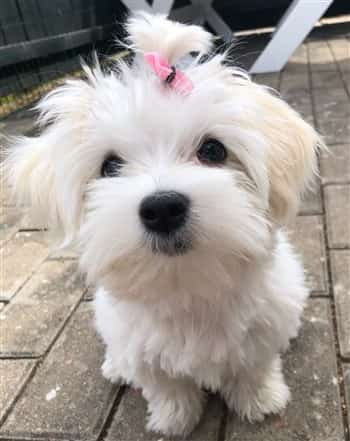
Chloe, photo courtesy of Amanda
The Top 4 Reasons a Maltese will Eat Grass
To stop a dog from eating grass, it helps to understand why this behavior develops. In most cases, it will be due to one or more of the following reasons:
1. Hunger linked to health issues.
Though this is certainly not the most common cause of a Maltese seeking out grass to eat, it is always wise to be aware that of the most common canine health issues that can lead to increased hunger: Canine diabetes, inflammatory bowel disease, hyperthyroidism, exocrine pancreatic insufficiency, parasitic worms (tapeworms, whipworms, hookworms), and gastrointestinal cancers.
2. Nutritional deficiency linked to fillers.
Dog food fillers are inexpensive ingredients added to the mix to provide bulk. It is done by less-than-reputable companies as a cost-saving method. Fillers make a dog feel full while providing little to no nutritional value. If your Maltese is regularly eating food with fillers, your dog may eat the entire bowlful of food but feel hungry soon afterward, leading to grass consumption since it is often an easily accessible ‘food source’ that can quell hunger.
3. Compulsive habit.
The reason behind to grass-eating behavior may simply be ‘because it’s there’. A Maltese may start chewing on grass due to being curious (hey, what’s this?) and find that they like the feeling of munching away on it or from being bored (there’s not much to do, maybe I’ll chomp on this interesting green stuff!) and they find that it’s a way to pass time.
Either way, once a dog eats grass and finds it to be soothing on some level, they may develop the habit of seeking it out.
4. Attention-seeking behavior.
Canines are highly skilled at learning what causes their owners to take note of them. If your Maltese eats grass and your normal response is to rush over and be overly animated and highly vocal, your little guy or gal may have found a way to get your attention.
Incoming cuteness...
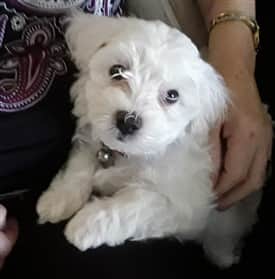
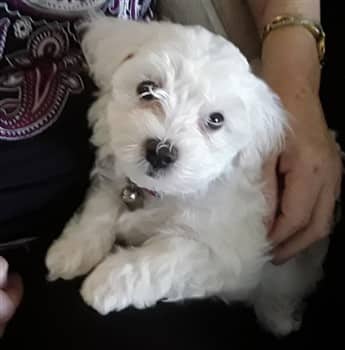
Rosie, photo courtesy of Patricia Gilbert
How to Prevent a Maltese From Eating Grass
Since it is clear that it is not good for a Maltese puppy or dog to eat grass, the most important aspect to all of this is how to stop it from happening. Fortunately, through a combination of several elements, it is indeed possible to greatly limit or outright stop this behavior. And, it can be done in just 5 steps:
Step 1: Have any possible health issues ruled out.
While most of the issues associated with increased appetite, and thus possibly grass ingestion, have a wide range of other symptoms, it’s always a good idea to bring your Maltese to the vet for a full physical. This will include a complete blood count which may flag nutritional deficiencies as either the underlying cause or as a result of long-term grass ingestion, along with stool sample testing, a urinalysis, and other tests to determine your Maltese’s general health.
Step 2: Assess your Maltese’s diet.
Any time that a dog is seeking out food other than his own, this is an indication that something may be lacking in the diet. Nowadays, there are opposing opinions regarding what sort of diet is best for canines. Some say grains can trigger allergies (though the majority of dogs can tolerate quality grains just fine) and others theorized that grain-free is linked to heart issues (though, this is based on small studies that looked primarily breeds prone to cardiomyopathy like the Boxer dog and referred to dog foods that had heavy carbs – like potatoes – as a main ingredient).
When all is said and done, the best you can do is choose a currently rated top-quality kibble, going with rice, other grains, or grain-free based on your Maltese’s past history of grain tolerance.
And, importantly, the food should have a healthy balance of protein, carbohydrates, and healthy fats, contain all of the vitamins and minerals that dogs need, have zero artificial preservatives, flavoring, coloring, or soy (these are the ingredients that make most dogs allergic to their food), as well as no by-products, generic meats or oils, or cheap fillers like corn or any sort of hull or husk.
In addition to this, the food should be sized for small dogs, have added extras like glucosamine and omegas, and be made in the USA.
If you are looking for a top-quality kibble that contains all of the above referenced elements, a good choice is Wellness CORE Natural for Small Breeds . This has a base of chicken and turkey.
. This has a base of chicken and turkey.
Another very good choice that offers more flavor options is Merrick Lil Plates Small Breed Recipe .
.
For dry snacks to offer in between meals, Old Mother Hubbard Crunchy Mini Biscuits
 is a fantastic choice.
is a fantastic choice.
And, for chewy moist treats that are given for reward, you can’t go wrong with Wellness Soft Natural Chewy Dog Treats .
.
Incoming cuteness...


Bella, photo courtesy of Charles Termini
Step 3: Supervise in the yard.
Yes, life may be easier for you if you just let your Maltese out the door into an enclosed yard, but doing so is dangerous for your little guy or gal. In addition to having free reign to eat as much grass as they desire, being outside without supervision brings about the risks of coming face to face with wild animals, larger dogs on the loose (that can jump fences), escape (through weak areas in the fence or small holes), ingestion of toxic plants or mushrooms, and exposure to the cold or heat.
Therefore, if you supervise your Maltese you can keep your puppy or dog safe from all of those things as well as interrupt attempts at munching on grass (details in next step).
Step 4: Interrupt and refocus.
There are a number of behaviors that can be corrected with the ‘interrupt and refocus’ technique, including grass ingestion.
Let’s look at each aspect:
#1 Interrupt.
Some Maltese will stop what they are doing if their human simply calls out their name or says ‘No’ in a firm tone with or without a loud hand clap. If so, this is all you’ll need to do. However, others need something a bit more attention-grabbing. One DIY method is to place a few coins into a metal jar, a quick shake can cause a dog to take pause.
If those methods do not work for your particular Maltese, you may wish to use what dog training professional use, which is a training tool like the The Company of Animals Pet Corrector
 that emits a short hissing sound. This particular noise causes dogs to stop in their tracks for a moment, and that is all you need to move onto #2.
that emits a short hissing sound. This particular noise causes dogs to stop in their tracks for a moment, and that is all you need to move onto #2.
#2 Refocus.
As soon as your Maltese takes pause and stops chewing at the grass for that brief moment, what you will redirect their attention to will depend on where you are and if there were any goals (i.e. going for a walk, bathroom needs, exercise, etc.).
For example, if the goal was to be taking a daily walk for exercise purposes, keep things moving along. Have your Maltese on a short or retractable leash and a harness (not a collar) like the Puppia Soft B Harness , so that you can redirect your dog without causing undue pressure on the neck (which can trigger collapsed trachea). Keep your Maltese to your immediate left and walk with purpose.
, so that you can redirect your dog without causing undue pressure on the neck (which can trigger collapsed trachea). Keep your Maltese to your immediate left and walk with purpose.
If the goal was to take your little guy or gal out for bathroom needs, once you have momentarily stopped the grass consumption, move your Maltese a few steps over and say the trigger words (‘Go potty’, etc.).
If the goal was to be outside for some exercise, grab your Maltese’s attention with a fun fetch toy and use an enthusiastic voice to encourage your dog to take chase. If your Maltese seems uninterested, it may be time to bring in some new fun toys that encourage outdoor playtime. Something like the Led Light Up Balls with Funny Sounds
 can be just the thing, these fetch balls have lights that show even in the daytime and make funny noises to trigger the chase instinct.
can be just the thing, these fetch balls have lights that show even in the daytime and make funny noises to trigger the chase instinct.
Incoming cuteness...
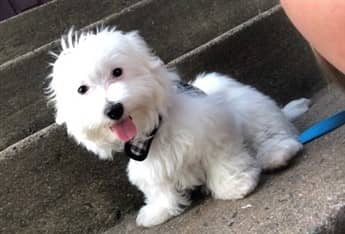
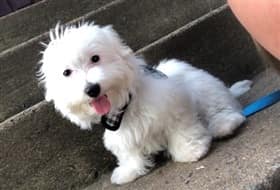
Marvin, at 13 weeks old, photo courtesy of Ximena Grijalva
Step 5: Offer methods to keep your Maltese busy.
There may be times when you want to be outside with your Maltese, but cannot directly engage your dog to keep them busy. Maybe you are barbequing, tending to your garden, or just want to relax on a lawn chair to read your new novel. But, this inevitably means that your Maltese will be chewing away on grass when you’re not looking.
Fortunately, there are some effective, fun ways to keep a dog busy in these situations.
During the summer, a water sprinkler can be lots of fun for dogs as they chase the moving sprays and dart in and out of the water to cool off.
And, just about year-round, a fun option is bubbles. If you’re busy and cannot blow these yourself, there are some great little automated machines like the Fansteck Automatic Bubble Machine
 that’ll do the work for you, producing never-ending bubbles for dogs to chase.
that’ll do the work for you, producing never-ending bubbles for dogs to chase.
There are also some toys that can keep a Maltese occupied. Treat-release toys like the can work well for this; fill this with a mixture of dry kibble and peanut butter or mashed banana (depending on what your Maltese finds most tempting).
Or, you might want to try an interactive toy like the Squeaky Giggle Ball . This is a plush one-eyed ‘monster’ toy that makes silly noises when it’s played with.
. This is a plush one-eyed ‘monster’ toy that makes silly noises when it’s played with.
A Final Word
If your Maltese has the habit of eating grass, this is not something that should be ignored. It can be detrimental in many ways including causing vomiting and/or digestive distress, lead to the ingestion of lawncare chemicals or toxic elements, can cause tooth decay, and can be a sign of nutritional deficiency.
By ruling out health issues, reassessing your Maltese’s diet, offering supervision, pre-planning how you will interrupt and refocus your dog, and offering ways to keep your Maltese busy while outside, the unhealthy behavior of eating grass can be resolved.
Spotlight Article
There is a huge difference between the two. Read the surprising risks of a collar and recommendations for harnesses.
Share Us
Share
Tweet
Share
Mail
All text and photographs protected by US and International copyright laws.
All rights reserved.
Contact Us
Contact@PetMaltese.comWe are a participant in the Amazon Services LLC Associates Program, an affiliate advertising program designed to provide a means for us to earn fees by linking to Amazon.com and affiliated sites.

-min-450x169-480w.jpg)
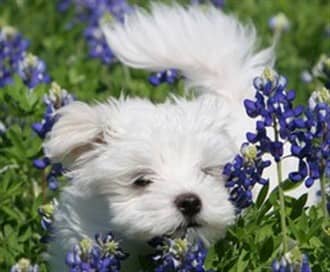
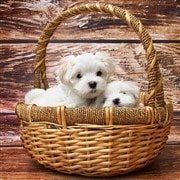
-min-180x187-344w.jpg)